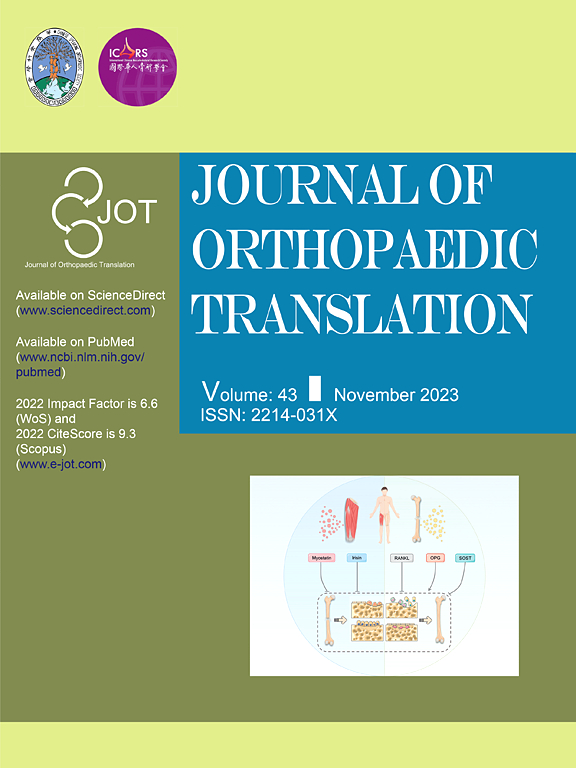氧化应激激活YAP/TEAD1/NCOA4轴,促进终板软骨细胞铁下垂,加重椎间盘退变
IF 5.9
1区 医学
Q1 ORTHOPEDICS
引用次数: 0
摘要
背景椎间盘退变(IDD)是腰痛的主要原因,其中软骨终板退变(CEP)起关键作用。而yes相关蛋白(YAP)及其在CEP变性和铁下垂中的作用尚不清楚。本研究旨在探讨YAP在CEP铁下垂中的调节作用及其潜在机制。方法分析syap在人CEP组织和小鼠LSI模型中的表达。用维替泊芬或YAP-siRNA处理CEP细胞。通过测量铁水平、脂质过氧化、谷胱甘肽含量和活力测定来评估下垂。利用CUT&;RUN-qPCR、dual-LUC和免疫荧光共定位技术阐明了分子机制。在LSI小鼠中评价维替波芬(VP)的治疗效果。结果syap下调可减轻氧化应激诱导的CEP软骨细胞变性和铁下垂特征。在机制上,我们发现氧化应激诱导的CEP软骨细胞变性涉及铁蛋白自噬,这是由YAP/TEAD1信号轴通过转录控制核共激活因子4 (NCOA4)调节的。使用一种YAP/TEAD1轴抑制剂维替波特芬治疗,通过靶向ncoa4介导的铁蛋白吞噬,有效地减少了CEP软骨细胞变性和IDD进展。结论通过详细的分子和细胞分析,我们发现YAP/TEAD1/NCOA4信号轴在CEP软骨细胞铁凋亡和IDD的发生中起着至关重要的调节作用。这些发现不仅增强了我们对IDD发病机制的理解,而且表明靶向YAP/TEAD1/NCOA4轴可能是治疗IDD的一种有前景的治疗策略。本研究揭示了YAP通过调节软骨终板细胞的铁下垂作为椎间盘退变的新治疗靶点,这为预防IDD提供了一种新的策略。本文章由计算机程序翻译,如有差异,请以英文原文为准。

Oxidative stress activates YAP/TEAD1/NCOA4 axis to promote ferroptosis of endplate chondrocytes and aggravate intervertebral disc degeneration
Background
Intervertebral disc degeneration (IDD) is a major cause of low back pain, with cartilaginous endplate (CEP) degeneration playing a critical role. While Yes-associated protein (YAP) and its involvement in CEP degeneration and ferroptosis remain unclear. This study aimed to investigate the regulatory role of YAP in CEP ferroptosis and its underlying mechanisms.
Methods
YAP expression was analyzed in human CEP tissues and mouse LSI models. CEP cells were treated with Verteporfin or YAP-siRNA. Ferroptosis was assessed by measuring iron levels, lipid peroxidation, GSH content, and viability assays. Molecular mechanisms were elucidated using CUT&RUN-qPCR, dual-LUC, and immunofluorescence colocalization. Verteporfin (VP) therapeutic efficacy was evaluated in LSI mice.
Results
YAP knockdown attenuated oxidative stress-induced CEP chondrocyte degeneration and ferroptosis features. Mechanistically, we identified that oxidative stress-induced CEP chondrocyte degeneration involves ferritinophagy, which is regulated by the YAP/TEAD1 signaling axis through transcriptional control of nuclear coactivator 4 (NCOA4). Treatment with verteporfin, a YAP/TEAD1 axis inhibitor, effectively reduced CEP chondrocyte degeneration and IDD progression by targeting NCOA4-mediated ferritinophagy.
Conclusion
Through detailed molecular and cellular analyses, we revealed that the YAP/TEAD1/NCOA4 signaling axis plays a crucial role in regulating CEP chondrocyte ferroptosis and IDD development. These findings not only enhance our understanding of IDD pathogenesis but also suggest that targeting the YAP/TEAD1/NCOA4 axis could be a promising therapeutic strategy for treating IDD.
The Translational Potential of this Article
This study reveals YAP as a novel therapeutic target for intervertebral disc degeneration by regulating ferroptosis in cartilage endplate cells, which provides a novel strategy in the prevention of IDD.
求助全文
通过发布文献求助,成功后即可免费获取论文全文。
去求助
来源期刊

Journal of Orthopaedic Translation
Medicine-Orthopedics and Sports Medicine
CiteScore
11.80
自引率
13.60%
发文量
91
审稿时长
29 days
期刊介绍:
The Journal of Orthopaedic Translation (JOT) is the official peer-reviewed, open access journal of the Chinese Speaking Orthopaedic Society (CSOS) and the International Chinese Musculoskeletal Research Society (ICMRS). It is published quarterly, in January, April, July and October, by Elsevier.
 求助内容:
求助内容: 应助结果提醒方式:
应助结果提醒方式:


